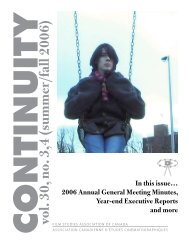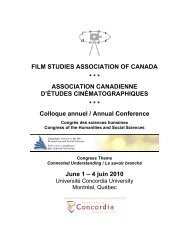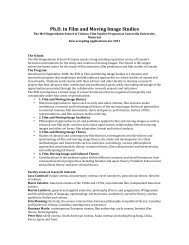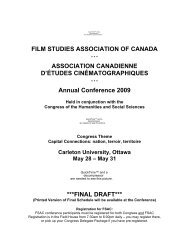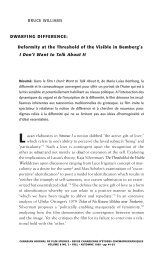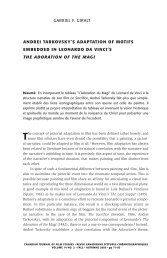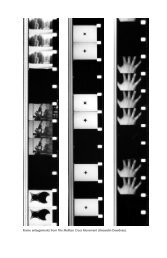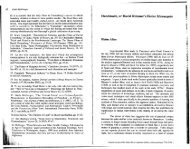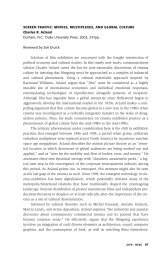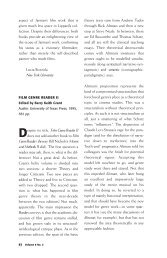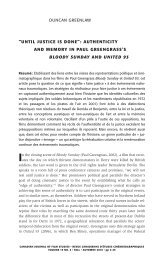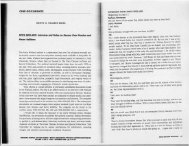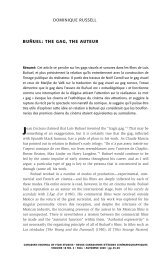PDF: Andrei Tarkovsky's Madonna Del Parto - Film Studies ...
PDF: Andrei Tarkovsky's Madonna Del Parto - Film Studies ...
PDF: Andrei Tarkovsky's Madonna Del Parto - Film Studies ...
Create successful ePaper yourself
Turn your PDF publications into a flip-book with our unique Google optimized e-Paper software.
JAMES MACGILLIVRAY<br />
ANDREI TARKOVSKY'S MADONNA DEL PARTO<br />
Resa.e: Les CEuvres d'art et rarchitecture sont toujours transformees et nHnscrites<br />
quand elles soot depeintes au cinema. I:auteur analyse ce processus en detail dans<br />
une scene de Nostolghio d'<strong>Andrei</strong> Tarkovsky qui exhibe la <strong>Madonna</strong> del Porto de<br />
Piero della Francesca. En etudiant les effets de la suture et de fespace cine<br />
matographique sur Yarchitecture, fauteur explique comment Tarkovsky change consciemment<br />
Ie sens de la fresque de Piero et de son environnement architectural en<br />
les reinscrivant dans son film.<br />
In July of 1984, <strong>Andrei</strong> Tarkovsky attended a press conference in Milan<br />
where he announced to the world that he would not return to the Soviet<br />
Union. When a journalist asked him if he would be seeking political exile<br />
in Italy, Tarkovsky answered, Jll'm telling you a drama. You cannot ask me<br />
bureaucratic questions. Which country? I don't know. It's like asking me<br />
in which cemetery I wish to bury my children.... 1 This laconic announcement<br />
came at the end of the drama that began in 1979 when he first chose<br />
to go to Italy to film NoslAI9bia (Italy, 1982, <strong>Andrei</strong> Tarkovsky). The film<br />
itself stands a5 a testament to his own experience of nostalgia during his<br />
exile; in fact Tarkovsky cans the protagonist, <strong>Andrei</strong> Gorchakov, a "mirror"<br />
of himselfl<br />
Gorchakov's eXile like <strong>Tarkovsky's</strong>, is expressed and manifested in a<br />
j<br />
project, the purpose of his trip to Italy is to research,the life of Pavel<br />
Sosnovsky, an 18th century serf composer whose nostalgia for Russia in<br />
Italy drives him to suicide. Sosnovsky's story within the film is a mirror in<br />
which Gorchakov can better perceive his own nostalgia. Tarkovsky, in<br />
tum, can be said to "work through" his own nostalgia by interrogating and<br />
manipulating the character of Gorchakov. Sosnovsky is therefore the<br />
diegetic denotation of a generative structure for the work, NoSlalgbia. As<br />
such, Sosnovsky is an example of a narrative device known as mis' ttl abyme,<br />
CANADIAN JouaNAl. OF RLM STUDllS .. REVUE CANAOIINMI D'truDlS CINUIATOGUP"IQUU<br />
VOLUME 11 MO. Z .. FALL .. AUTOMMllln .. pp a1.-"<br />
a condition in a work of art where a fragment of the work replicates, in<br />
miniature, the entire composition of the work. The mist eli abymt of<br />
NOSfJ:J19bia is unique because the symmetry across scales (a story within a<br />
story) ultimately points back to Tarkovsky. The making of Nosla19bia, the<br />
nostalgia of Tarkovsky himself, is contained within N051419bia. In ScuJplin9<br />
in Time, he says that "the camera was obeying first and foremost my inner<br />
state during filming." 3 In this sense, the technical aspect of Nostalgbia impli·<br />
cates Tarkovskys inner state just as the behaviour of Gorchakov follows<br />
the imperatives of the film's production.<br />
The first scene of the film, Eugenia and Corchakov's visit to the<br />
Mad"".a dtl Parlo, exemplifies Noslalgbia's ambiguous agency. Gorchakov<br />
wants to see the painting because it reminds him of his wife. Tarkovsky<br />
chooses the painting because it reminds him of his wife. Tarkovsky also<br />
chooses the painting because it is not well known and, therefore, allows<br />
him greater artistic license in using it in his film. By contrast, heavily<br />
touristed sights like the Campidoglio require a total fidelity in order to<br />
be plausible to an international audience. At Piero's freseo however, he<br />
j<br />
can and does take great liberties manipulating the painting so that it "fits"<br />
in his film. Gorchakov goes to the out of the way location for a similar<br />
reason: he dislikes tourists.<br />
Yet, the question that lies at the heart of the scene remains, why, after<br />
traveling hundreds of miles to see the <strong>Madonna</strong> does Gorchakov not enter<br />
the chapel? The answer to this question lies in the relationship between<br />
Gorchakov and Tarkovsky. This paper wishes to show that in this first<br />
scene of Noslalgbia the Madon"" dd Parlo is refracted and reAected in the<br />
mirrors of the film's mise t» abymt, until it becomes something fundamenrally<br />
different, both emotionally/culturally and technically. It will be<br />
shown that this scene incorporat.es two primary artistic manipulations of<br />
the <strong>Madonna</strong> drl <strong>Parto</strong> in order to present <strong>Tarkovsky's</strong> idea of the work. The<br />
first manipulation is to move the freseo to a new architectural site and to<br />
manipulate the architecture of this new site as a decentralized field condition<br />
that brings the painting into the film. The second, and overarching<br />
manipulation is to create the ritual of the Cult of the Virgin, a new<br />
meaning for the painting itself. It is precisely the extent and breadth of<br />
these intetventions that exclude Gorchakov from being present in the<br />
chapel. As the director, or what he refers to in SCI41ptin9 in lim( as the<br />
Itdemiurge" of the film," Tarkovsky must have felt that his own presence<br />
in the scene was too strong to include his stand-in protagonist.<br />
Corchakov must wait outside.
Figure S. The exteriQr of San Pietro, facing southeast. (Enrico Parln and Serena Romano,<br />
ItDIio Rom,mico, Romo • J I.ozio. vol. t 3, 1992)<br />
they mu"t do so to such a way as not to "depnvc the ram of what IS dis<br />
tinctively l:.nematic,"<br />
The condJt1ons for cinematic integnty in the appearance or ("he<br />
<strong>Madonna</strong> become even more complex when layered with considerations<br />
or the integrity of Ihe painted work. Palntmgs have lheir own laws that<br />
are compromIsed when depIcted in 3 film. Comune dJ tv1onterchi's desire<br />
to relocate 'he fresco was known by Tarkov ky when he folmed " for<br />
T""po J, Vwgg.o, "We filmed Piero della Francesca's Mldo"". oj Cbildb,rtb in<br />
1\,1ontcrchi. No reproduction can give any Idea of how beaUtiful it IS. A<br />
cemetcry on the borders of Tuscany and Umbria. When they wantc:d to<br />
transfcr the <strong>Madonna</strong> to a museum, the local women prolested and<br />
Inslsled on her staymg· u (As already noted, however, the fresco was<br />
moved fO the museum In 1992.) In hJS journal entry and in his conversations<br />
with Guerra In the film, Tarkovsky is clearly 10 agreement with the<br />
local women on Ihe: Importance of keeping the work in its anglOal sile.<br />
On thIS subject Guern is even more outspoken, whIle they look at a<br />
n::productlon of the <strong>Madonna</strong> m a book, he: saYSf 1"11e reproductl n loses



